Surface Settlement of Deep Foundation Pit Considering the Influence of Excavation and Freeze–Thaw
Abstract
1. Introduction
2. Model Trial of the Foundation Pit with Pile Support
2.1. Overview of Model Trials
2.2. Analysis of Experimental Results
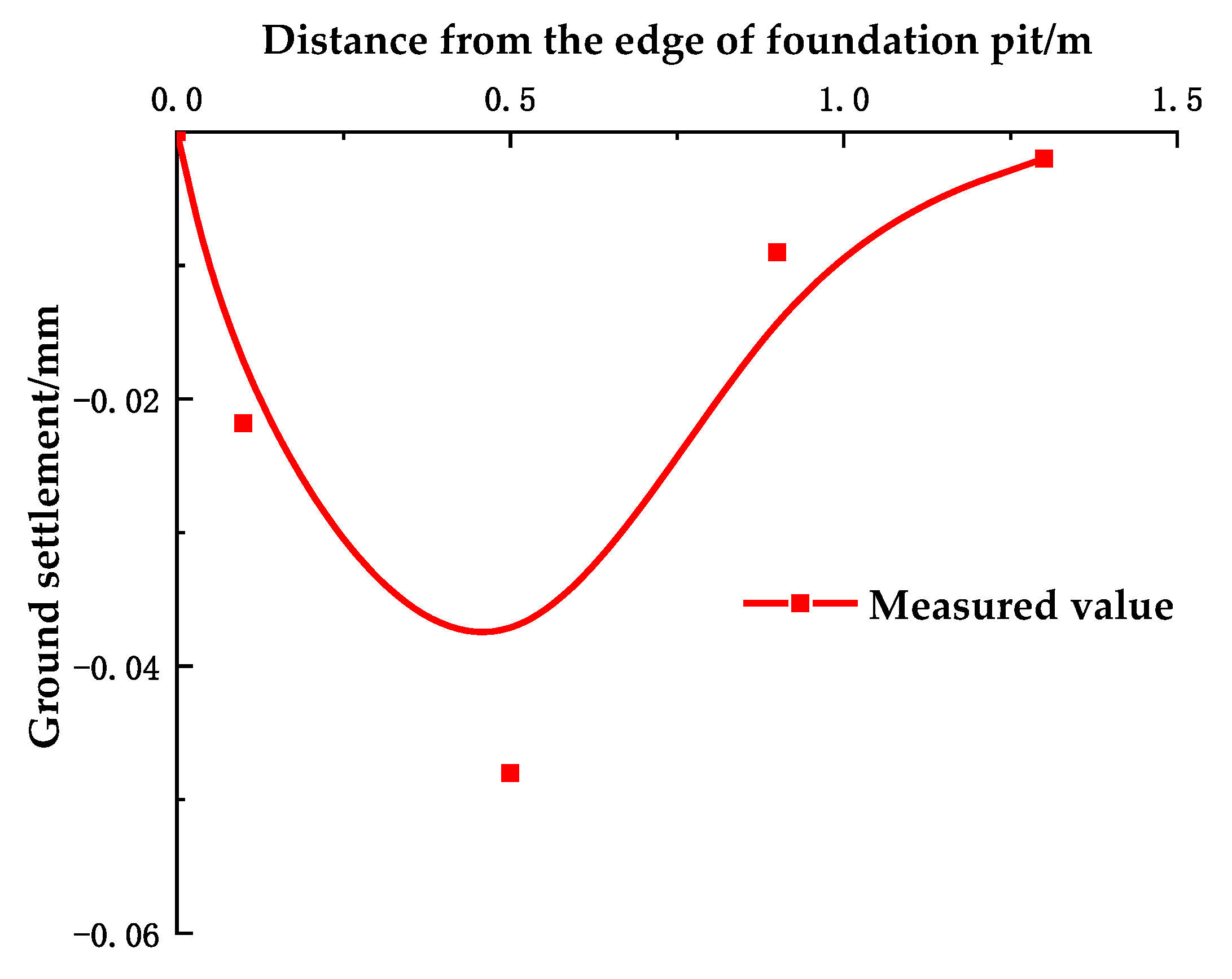
3. Investigation of the Surface Settlement Distribution Pattern During Foundation Pit Excavation and Freeze–Thaw Cycles
3.1. Deformation of Supporting Structure and Internal Water Migration of Soil
3.2. Establishment of Calculation Model for Ground Settlement of Foundation Pit Considering Excavation and Freeze–Thaw
3.3. Model Verification
4. Analysis of the Quantity of Freezes–Thaws Affects the Pit Surface’s Settlement
5. Conclusions
- Based on the indoor scaling model test used to analyze the deformation of the supporting structure and moisture migration of the pit soil during the freeze–thaw process, the study demonstrated that the freezing depth was approximately 1.1 m, the displacement of the supporting structure increased with the number of freeze–thaw times, the coordination of the deformation between the supporting structure and the soil would increase the surface settlement, and the freeze–thaw cycle would cause the migration of moisture from the frozen area to the unfrozen area.
- Under the impact of freeze–thaw cycles, surface settlement around the foundation pit first rose, reaching its maximum during the first cycle. Surface settlement had a maximum value of 1.082 mm, declined as the number of freeze–thaw cycles increased, and stabilized after eight cycles. This emphasizes how crucial it is to take early-stage surface deformation into account for foundation pit safety and stability.
- The calculation model of the surface settlement distribution pattern of the pile-anchor-supported deep foundation pit was optimized, and the method of calculating the settlement at any point of the surface under various freeze–thaw conditions was obtained based on the relationship between the maximum value of surface settlement and the number of freezing and thawing cycles. It was discovered that the surface settlement curves created during the excavation and freeze–thaw process of the foundation pit were skewed distributions.
Author Contributions
Funding
Data Availability Statement
Conflicts of Interest
References
- Chen, H.H.; Li, J.P.; Yang, C.Y.; Feng, C. A theoretical study on ground surface settlement induced by a braced deep excavation. Eur. J. Environ. Civ. Eng. 2018, 10, 1080–1100. [Google Scholar]
- Dan, K.; Sahu, R.B. Estimation of ground movement and wall deflection in braced excavation by minimum potential energy approach. Int. J. Geomech. 2018, 18, 04018068. [Google Scholar]
- Zhang, D.W.; Shu, J.C.; Sun, J.P. Observed deformation characteristics of a deep excavation for the spring area in Jinan. J. Mt. Sci. 2017, 14, 581–594. [Google Scholar]
- Hsieh, P.G.; Ou, C.Y. Simplified approach to estimate the maximum wall deflection for deep excavations with cross walls in clay under the undrained condition. Acta Geotech. 2016, 11, 177–189. [Google Scholar]
- Lim, A.; Ou, C.Y. Stress paths in deep excavations under undrained conditions and its influence on deformation analysis. Tunn. Undergr. Space Technol. 2017, 63, 118–132. [Google Scholar]
- Liyana, D.S.; Nishanthan, R. Influence of deep excavation induced ground movements on adjacent piles. Tunn. Undergr. Space Technol. 2016, 52, 168–181. [Google Scholar]
- Li, Y.X.; Zhang, W.Y.; Jiang, N.S. Surface Settlement Damage Model of Pile-Anchor Supporting Structure in Deep Excavation. Adv. Civ. Eng. 2020, 10, 115–128. [Google Scholar]
- Qu, Y.L.; Niu, W.K.; Niu, F.J. Shear Properties and Mechanism of Freeze-Thaw Interface in Unsaturated Coarse-Grained Soil from Qinghai-Tibet Plateau. Adv. Civ. Eng. 2021, 10, 1155–1163. [Google Scholar]
- Wang, Q.S.; Li, Y.J.; Li, P.; Qi, Y.P. Using Cement and Calcium Lignosulfonate to Improve the Mechanical Properties and Microstructure of Loess in a Seasonal Freezing Zone. Build. 2024, 14, 14061945. [Google Scholar]
- Lu, B.; Zhao, W.; Li, S.J.; Dong, M.M. Study on Seasonal Permafrost Roadbed Deformation Based on Water–Heat Coupling Characteristics. Buildings 2024, 14, 2710. [Google Scholar] [CrossRef]
- Tang, M.X.; Zhao, X.H. Analysis of ground settlement around deep excavation. Build. Sci. 1996, 4, 31–35. [Google Scholar]
- Nie, Z.Q.; Zhang, S.G.; Meng, S.P. Surface settlement of deep foundation pits by excavation. Chin. J. Geotech. Eng. 2008, 30, 1218–1223. [Google Scholar]
- Zhang, S.; Wang, D.S.; Peprah-Manu, D.; Wang, Y.; Ng, C.W. Cyclic freeze–thaw induced stiffness anisotropy of sandy silt under all-round and unidirectional freezing modes. Catena 2024, 236, 107749. [Google Scholar] [CrossRef]
- Li, Y.X.; Zhu, Y.P.; Ye, S.H.; Ma, X.R. Skewness distribution patterns of surface settlement considering overload effect. Chin. J. Geotech. Eng. 2018, 40, 171–176. [Google Scholar]
- Mo, D.; Gong, B.D. Analysis of settlement of adjacent shallow foundation buildings induced by foundation pit excavation. Build. Struct. 2022, 52, 2315–2321. [Google Scholar]
- Yang, X.H.; Cai, S.C.; He, S.H.; Shao, Y.; Yan, C.-G. Force and deformation characteristics of subway station foundation pit under severe cold condition. J. Traffic Transp. Eng. 2023, 23, 233–247. [Google Scholar]
- Liu, G.B.; Wang, W.D. Foundation Pit Engineering Manual, 2nd ed.; China Building Industry Press: Beijing, China, 2009. [Google Scholar]
- Gao, X.Y. Freeze-Thaw Damage Model of Deep Excavation Settlement in Loess Areas of Xining; Qinghai University: Xining, China, 2022. [Google Scholar]
- Li, H.; Song, Y.Y.; Zhou, J.; Li, J.; Shen, Z. Filed Test of Pile-anchor Retaining Structure Mechanical and Deformation Characteristics in Deep Foundation Pit. Chin. J. Undergr. Space Eng. 2017, 13, 264–270. [Google Scholar]
- Zhu, L. Study on Performance of Prestressed Pile Anchor System for Deep Foundation Pit during Spring Thaw in High Lati Cold Zone; Harbin Polytechnic Institute: Ha’erbin, China, 2022. [Google Scholar]
- Wu, D.Y.; Lai, Y.M.; Ma, Q.G.; Wang, C. Model test study of water and salt migration and deformation characteristics in seasonally frozen soil. Rock Soil Mech. 2016, 37, 465–476. [Google Scholar]
- Wang, T.L.; Bu, J.Q.; Wang, Y.; Xu, L.; Yan, H. Thaw subsidence properties of soils under repeated freeze-thaw cycles. Chin. J. Geotech. Eng. 2014, 36, 625–632. [Google Scholar]
- Ling, Y.Q.; Song, L.; Hao, J. Analytical analysis for horizontal displacement of pile anchor support structure considering prestress. Front. Ecol. Evol. 2023, 11, 1239–1249. [Google Scholar] [CrossRef]
- Bai, Q.B.; Li, X.; Tian, Y.H.; Fang, J.H. Equations and numerical simulation for coupled water and heat transfer in frozen soil. Chin. J. Geotech. Eng. 2015, 37, 131–136. [Google Scholar]
- Masum, S.A.; Kirk, G.J.; Daly, K.R.; Roose, T. The effect of non-uniform microscale distribution of sorption sites on solute diffusion in soil. Eur. J. Soil Sci. 2016, 67, 514–522. [Google Scholar] [CrossRef]
- Teng, J.; Zhang, X.; Zhang, S. An analytical model for evaporation from unsaturated soil. Comput. Geotech. 2019, 108, 107–116. [Google Scholar] [CrossRef]
- Wan, X.; Gong, F.; Qu, M. Experimental study of the salt transfer in a cold sodium sulfate soil. KSCE J. Civ. Eng. 2019, 23, 1573–1585. [Google Scholar] [CrossRef]





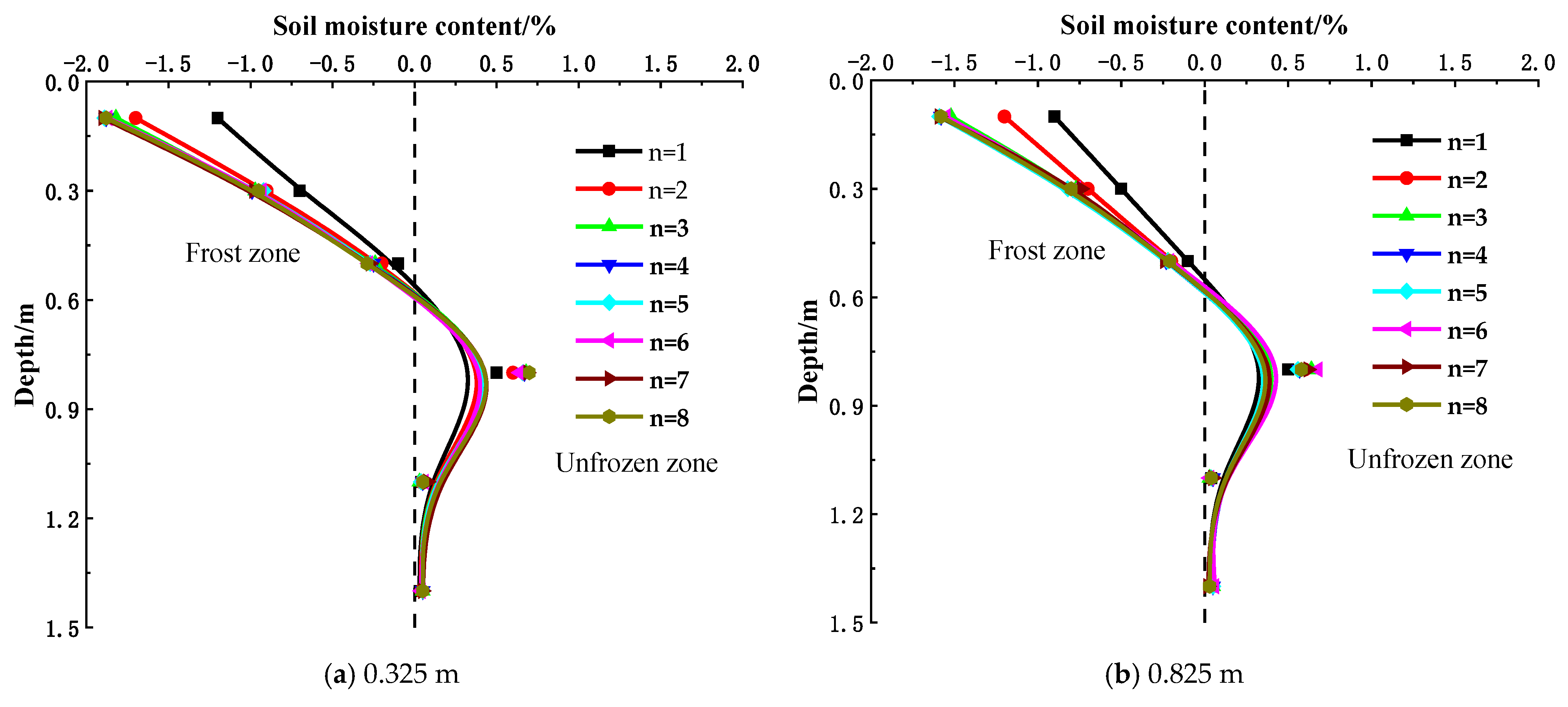

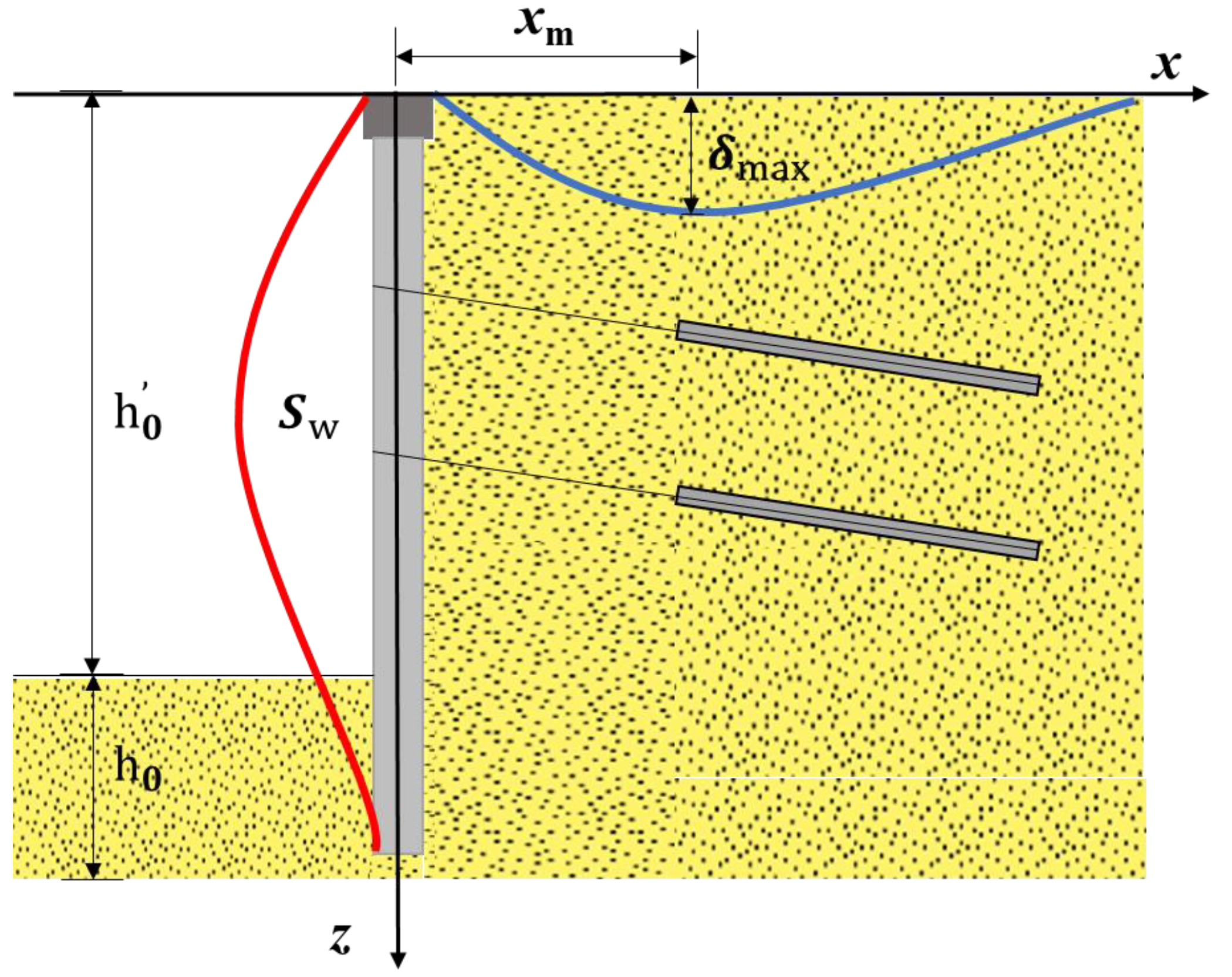
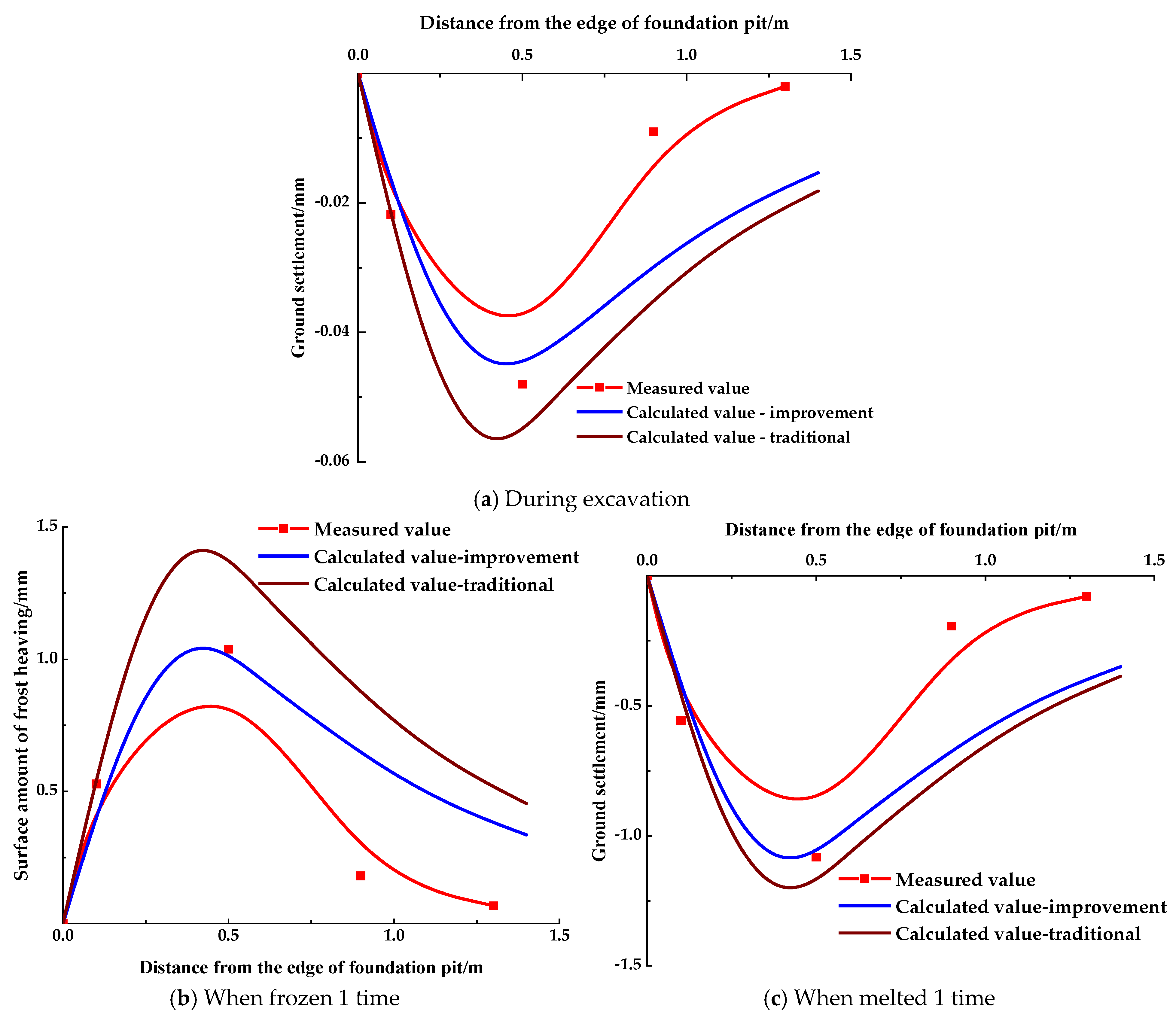


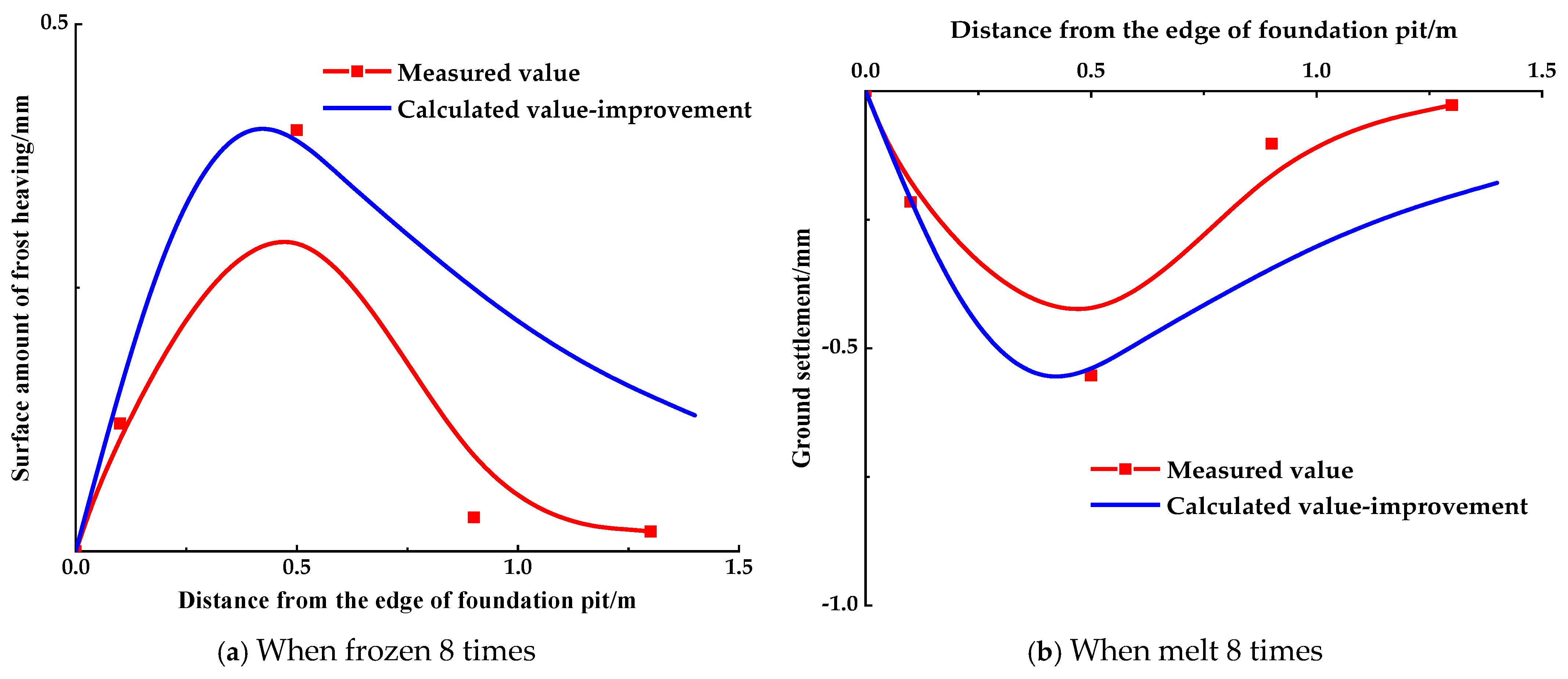
| Soil Group | Density | Gravity | Area | Water Content /% |
|---|---|---|---|---|
| Loess | 1.71 | 18 | 2400 | 10.48 |
| Working Condition | a | b | c | R2 |
|---|---|---|---|---|
| Freeze | −0.543 | −0.832 | 2.388 | 0.974 |
| Thaw | 0.390 | 0.991 | 2.413 | 0.977 |
Disclaimer/Publisher’s Note: The statements, opinions and data contained in all publications are solely those of the individual author(s) and contributor(s) and not of MDPI and/or the editor(s). MDPI and/or the editor(s) disclaim responsibility for any injury to people or property resulting from any ideas, methods, instructions or products referred to in the content. |
© 2025 by the authors. Licensee MDPI, Basel, Switzerland. This article is an open access article distributed under the terms and conditions of the Creative Commons Attribution (CC BY) license (https://creativecommons.org/licenses/by/4.0/).
Share and Cite
Li, Y.; Chen, S.; Ma, C.; Shi, J. Surface Settlement of Deep Foundation Pit Considering the Influence of Excavation and Freeze–Thaw. Buildings 2025, 15, 1104. https://doi.org/10.3390/buildings15071104
Li Y, Chen S, Ma C, Shi J. Surface Settlement of Deep Foundation Pit Considering the Influence of Excavation and Freeze–Thaw. Buildings. 2025; 15(7):1104. https://doi.org/10.3390/buildings15071104
Chicago/Turabian StyleLi, Yuanxun, Song Chen, Chuan Ma, and Jiagen Shi. 2025. "Surface Settlement of Deep Foundation Pit Considering the Influence of Excavation and Freeze–Thaw" Buildings 15, no. 7: 1104. https://doi.org/10.3390/buildings15071104
APA StyleLi, Y., Chen, S., Ma, C., & Shi, J. (2025). Surface Settlement of Deep Foundation Pit Considering the Influence of Excavation and Freeze–Thaw. Buildings, 15(7), 1104. https://doi.org/10.3390/buildings15071104






